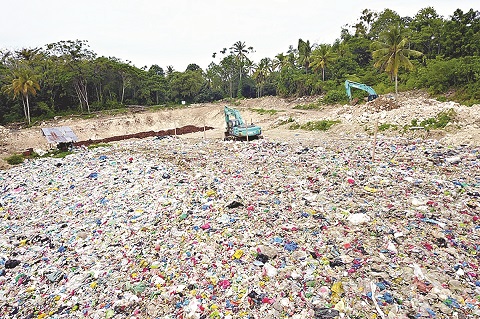
By ERWIN MASCARIÑAS
Correspondent .
THE local governments of San Isidro in Davao Oriental and Samal in Davao del Norte are the first in Mindanao to a declaration of intent towards the World Wide Fund (WWF) for Nature’s Plastic Smart Cities Project.

The WWF project aims to commit the local governments to a policy that would promote awareness and action towards the elimination of plastic pollution by 2030.
Chrisma Salao, vice president of the Conservation Program with WWF-Philippines, said WWF has been working in the Davao Gulf area since 2008 and has worked with the two local governments in the past with projects on climate change adaptation and marine protected areas.
“We are excited to support the implementation of the project with the LGUs (local government units) on the implementation of the Solid Waste Management plan, specifically on residual processing and campaigning to raise awareness,” said Salao.
Salao said an estimated 80 percent of plastic marine debris comes from land-based sources with a large portion coming from the urban areas as polluted waterways carry plastic pollution to the oceans.
“While cities and towns will grow to account for two-thirds of the global population by 2050, communities must continue to adopt smart solutions that reduce the collective impact of their prospering communities. This means preventing, minimizing, and managing plastic both as a resource and as waste,” she said.
On Monday, Samal became the first city in Mindanao to sign the memorandum of agreement with WWF.
“The partnership with WWF is timely as it will help us with the implementation of our environmental code in helping the reduction of plastic to hopefully increase the target lifespan of our existing sanitary landfill,” said Samal Mayor Al David Uy.
Uy said the island city has an existing ordinance, one of which is the establishment of the sanitary landfill and the soon-to-be built Talikod Island material recovery facility that goes hand in hand with current recycling and segregation of garbage.
“We have an area close to 15 hectares for our sanitary landfill with an estimated life span of 10 to 15 years, but with the coming of the bridge, this will increase the number of people visiting the island and we fear that it will cut the life span of our existing landfill,” said Uy.
Samal officials hope to find alternative means of creating packaging that is made from bio-degradable materials, with water refilling fountains in the city hall grounds.
“We need to first start the program and implementation within the grounds of the city government before we could strictly implement in the barangay levels. Hopefully, this will be adopted by our private partners especially with the tourism sector,” he said.
Mayor Justina Yu of San Isidro said the fight against plastic pollution is essential for the town that has seven coastal barangays.
“We are a small town but we have been constantly at the forefront of the protection of our environment. Since the ’90s, our marine protected areas and reefs have been part of the National Integrated Protected Area Systems Act. We also have the only Unesco world heritage site in Mindanao, Mount Hamiguitan Range Wildlife Sanctuary,” said Yu.
San Isidro town has an existing program on solid waste management called “Dili Nako sa Plastic.”
WWF said to stop the eight million tons of plastic wastes that leak into the ocean each year, WWF hopes to be working on achieving a 100-percent plastic waste diversion by 2030 through residuals processing, creating education campaigns and strengthening the different programs of the local governments.
Disclaimer
Mindanao Gold Star Daily holds the copyrights of all articles and photos in perpetuity. Any unauthorized reproduction in any platform, electronic and hardcopy, shall be liable for copyright infringement under the Intellectual Property Rights Law of the Philippines.









